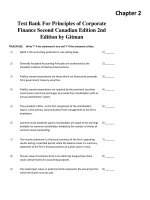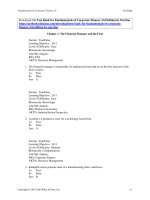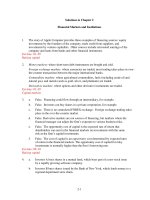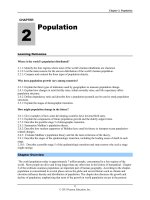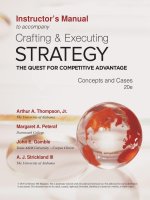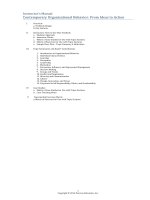Test bank solution manual of corporate finance ch02 FInancial management (1)
Bạn đang xem bản rút gọn của tài liệu. Xem và tải ngay bản đầy đủ của tài liệu tại đây (811.56 KB, 7 trang )
Corporate Finance
Instructor’s Manual
Chapter 2
Financial Management
Synopsis
The purpose of this chapter is to introduce the reader to the forms of business, and the
relation between the forms of business and the objectives of financial management. We
focus on agency issues and the alignment of incentives with the objectives of shareholders
and other stakeholders.
This is important groundwork to help students understanding the framework in which
investment and financing decisions are made.
Learning Outcomes
LO 2.1 List the advantages and disadvantages of the primary forms of a business
organization.
LO 2.2 Describe the ultimate objective of a company and explain why this is a logical
objective.
LO 2.3 List and describe agency costs and how they may affect owners’ wealth.
LO 2.4 Discuss the primary types of decisions made by business entities regarding the
financial management of assets, as well as the associated financing decisions.
Chapter Outline
2.1
Forms of business organizations
A.
B.
C.
D.
E.
F.
2.2
The goals of the business enterprise
A.
B.
2.3
Sole proprietorship
Partnerships
Corporations
Limited Liability companies
Subchapter S corporations
Prevalence
Stakeholders
The goal of the business enterprise
The role of management and agency issues
A.
The agency relationship and agency costs
Copyright © 2014 John Wiley & Sons, Inc.
2-1
Corporate Finance
B.
2.4
Instructor’s Manual
Aligning managers’ and owners’ interests
Financial management
A.
B.
Investment decisions
Financing decisions
Discussion Questions for Special Features
Feature
Opening vignette: Social
Responsibility
Learning
outcome
2.2
Discussion questions
1. Is Green Mountain’s business ethics reflected in
its market value? How would you know?
2. If the company were to buy products from
environmentally sensitive areas, but doing so
saves money, is this consistent with maximizing
shareholder wealth? Explain.
3. Do Green Mountain’s ethical principles put the
company at a comparative disadvantage relative
to its competitors?
Look up the stock: GMCR
Global Perspectives: Forms of
Business
2.1
1. Some familiar companies are actually
headquartered in other countries. Which
country is Bayer AG headquartered?
2. The limited liability company originated in
Germany in 1892, and its use in the U.S. is
relatively new (since the 1970s). Why would the
limited liability company be a popular form both
in the U.S. and elsewhere?
Lessons to be learned: Economic
Value Added
2.2
1. Why is focusing on earnings per share shortsighted?
2. If a company generates negative economic
profit, what does this mean?
Finance in the News: General
Electric Sheds Light on its
Smooth Earnings
2.3
1. Who may be harmed by the earnings
smoothing?
2. What type of agency cost is involved in this
case?
Check out the stock: GE
Ethics: The cost of fraud
2.4
1. Who, if anyone, is harmed in the case of the
manipulation of accounting information?
2. Which managers should be held accountable for
accounting fraud?
3. Why is a clawback used in these cases?
Check out the stock: BZH
Copyright © 2014 John Wiley & Sons, Inc.
2-2
Corporate Finance
Instructor’s Manual
Concept Review Questions
2.1
Forms of business organizations
2.2
1.
Sole proprietorships’ advantages include control of the management of the enterprise, one layer
of taxation. Sole proprietorships’ disadvantages include lack of access to capital markets, limited
external financing, and limited life of the enterprise, Partnerships have similar advantages and
disadvantages as sole proprietorships, but also require a partnership agreement to determine
the division of control and income.
2.
The advantage of an LLC is that there is limited liability for its owners, whereas for partnerships
there is unlimited liability for each partner.
3.
The primary advantage of the corporate structure is that it has access to capital markets and can
therefore issue debt or equity. Another advantage is that the enterprise has an unlimited life.
One disadvantage of the corporate structure is that there are two (or more) layers of taxation.
Another disadvantage is that for large corporations, there is a separation of management and
owners.
The goals of the business enterprise
2.3
1.
The primary goal of a corporation is to maximize shareholders’ wealth.
2.
The stakeholders of a company include the shareholders, the employees, and the community in
which is does business.
The role of management and agency issues
2.4
1.
In small businesses, especially in sole proprietorships and partnerships, the owners are typically
the managers. For large enterprises, and especially corporations, there is a separation of owners
and managers, raising the possibility of agency costs/
2.
Agency costs are direct costs, such as the monitoring costs of producing annual reports, and
indirect costs (e.g., managers making decisions that are self-serving) associated with addressing
potential problems with the separation of management and ownership.
3.
It has been believed that aligning management’s interests with those of shareholders by
increasing the focus on share price through stock options would reduce agency costs. However,
these have not worked as well as expected because these options do not always result in stock
ownership and a long-term perspective.
Financial management
1.
The financial management of assets requires making decisions regarding long-term investments
(capital budgeting) and short-term, operating assets.
2.
Key financing decisions include managing short-term sources of financing to meet seasonal or
cyclical needs, and the capital structure decision, which is deciding how much debt is
appropriate, relative to equity.
Answers to Multiple Choice Questions
1.
2.
3.
4.
A
C
A
A
Copyright © 2014 John Wiley & Sons, Inc.
2-3
Corporate Finance
Instructor’s Manual
5. B
6. C
7. B
8. C
9. B
10. B
Solutions to Practice Questions and Problems
2.1
Forms of business enterprise
11.
Form of
business
Sole
proprietorship
Liability Life
Unlimited Limited
Taxation
Flow
through
Partnership
Unlimited Limited
Flow
through
Corporation
Limited
Unlimited Double
taxation
Limited liability
company
Limited
Unlimited Flow
through
Access to
capital
Limited
Limited
Can issue
debt and
equity
Limited
Management and
owners
relationship
Manager and
owner are the
same
Manager and
owner are often
the same
Separation of
management and
owners
Depends on the
size of the
company and
structure
12. Primary differences:
1. Taxation (partnership income taxed once, corporate income taxed at the
corporate level and at the owners’ level when distributed).
2. Liability (partners have unlimited liability; shareholders have limited liability).
3. Life (partnership has a limited life; a corporation is perpetual).
13. Flow-through taxation is taxation on the income after it flows through the business to
the owners.
14. Comparing the two strategies, the LLC is preferred to the Subchapter S except with
respect to the life of the business entity. The Subchapter S has the advantage that it has
a perpetual life.
Characteristic Sub S
Taxation
Pass-through
Ownership
Maximum of 75
Copyright © 2014 John Wiley & Sons, Inc.
LLC
Pass-through
No maximum
Advantage to:
LLC
LLC
2-4
Corporate Finance
Liability
Life
Instructor’s Manual
shareholders
Limited liability
Perpetual
15.
Dividend Corporate
Payout
Tax Rate
40%
45%
A.
20%
40%
B.
25%
35%
C.
25%
40%
D.
Limited liability
Limited
Shareholders’
Tax on Dividend
Income
15%
0%
15%
15%
-Sub S
Effective Tax on
Corporate Income
0.483 or 48.3%
0.4 or 40%
0.374375 or 37.44%
0.4225 or 42.25%
16. Corporate tax rate = 40%; individual tax rate = 32%
Corporate taxable income
Corporate tax
Corporate income after tax
Distribution to shareholders
Shareholders’ tax
Income after tax
17.
2.2
$5,000,000
2,000,000
$3,000,000
$750,000
240,000
$510,000
The effective tax rate is ($240,000 + 2,000,000) ÷ $5,000,000 = 44.8%
A. 36%
B. effective rate = 0.36 + [(1-0.36) × 1 × 0.40] = 0.36 + 0.256 = 61.6%
C. effective rate = 0.36 + [(1-0.36) × 1 × 0.20] = 0.36 + 0.128 = 48.8%
The goals of the business enterprise
18. To maximize the value of the ownership interest.
19. A stakeholder is any party that is affected by the business entity, including shareholders
and employees.
20. Earnings represent the results of the assets in place, as well as accounting principles
selected to reflect past performance. The value of equity is forward-looking.
21. In a competitive market, if a company maximizes owners’ wealth, this will result in an
efficient allocation of resources because the company will want to make those decisions
– that involve resources – that are the best uses of these resources.
2.3
The role of managers and agency issues
22. Agency costs are direct and indirect costs resulting from agents (the managers) acting
in the best interests of the principals (shareholders). Examples: the cost of creating an
annual report; the costs of arranging board of directors’ meetings; managers consuming
perquisites (e.g., country club membership paid by the company).
Copyright © 2014 John Wiley & Sons, Inc.
2-5
Corporate Finance
Instructor’s Manual
23. Example 1: If another company proposes an acquisition, managers that are self-serving
may reject a bid that provides shareholders with a price above the current market
value. Example 2: Managers may use company property, such as a corporate jet, for
personal benefit.
24. Shareholders electing members of the board of directors who will be diligent in
monitoring management; devise a compensation scheme that relates performance to
pay (e.g., restricted stock grants); becoming a publicly-traded corporation, with
monitoring by analysts and the disclosure requirements of the SEC.
25. Earnings can be manipulated or managed; the relation between earnings and value is
not strong because earnings are historical (that is, based on past decisions) and value is
forward-looking.
26. The reasoning is that if the executive has stock option, he/she will want to maximize the
price of the company’s stock.
27. Shareholders elect a board of directors, who monitor management.
2.4
Financial management
28. Capital structure is how a company finances its assets through debt and equity.
29. The focus in evaluating an investment project is the risk of the project and how the
investment project will affect the company’s futures cash flows.
30.
Decision
Buying a new plant
Acquiring another company
Issuing a bond
A corporation buying back its own
stock
Borrowing from a bank
31.
Proportion of current assets
Investment Financing
Hewlett-Packard
43%
Boeing
59%
Verizon
10%
Hewlett-Packard and Boeing are both manufacturers, so they need to maintain an
inventory of raw materials sufficient to support the production process, as well as
inventory in process and finished goods. Boeing manufactures aircraft, which are
built to specifications and have a long production process; hence Boeing has a
greater need for working capital.
Verizon is a telecommunications company, which is, in large part, a service
company. The inventory and receivables for this company would be much smaller
than that of the other two companies.
Copyright © 2014 John Wiley & Sons, Inc.
2-6
Corporate Finance
Instructor’s Manual
Solutions to Cases
Case 2.1
The Tex Tech Company
A. Dan should choose Project B, which would increase the value of the firm by more
than Project A. If Dan is self-serving, he would be tempted to select project A, which
provides a higher bonus for him.
B. The owner likely prefers Project B, the project that produces the greater value.
C. Altering the bonus scheme, such that the bonus is a function of the value of Tex
Tech.
Case 2.2
To Invest or not to Invest
A. Factors to consider:
1. How many years will the new system benefit the company?
2. What is the risk that the savings will be less than expected?
3. What is the cost of capital for the company? Considerations: the cost of
equity, the amount of debt and equity the company uses (i.e., its capital
structure), and tax rate (because the $10,000 in interest is tax deductible).
B. The determination cannot be made on the basis of this information. If the company
pays taxes, the cost of the debt will be less than $10,000 and there would be profit
before considering the cost of equity for the company.
Copyright © 2014 John Wiley & Sons, Inc.
2-7
